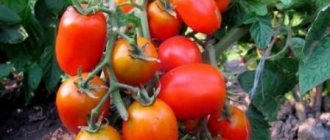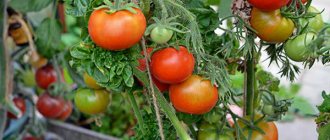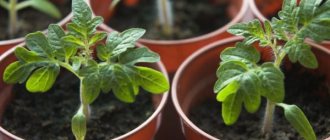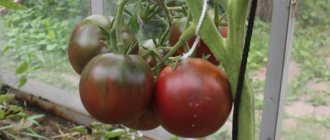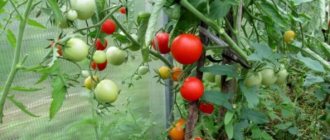| Ripening period: | early |
| Shape, weight of fruits: | Klusha - flat-round, 100 g, Super Klusha - round, 150-250 g |
| Bush type: | determinant |
| Growing regions: | everywhere |
| Productivity per bush: | Klusha - up to 2.5 kg, Super Klusha - up to 3 kg |
Gardeners in risky farming zones especially value tomatoes that can produce crops in open ground. Thanks to agriculture, such varieties appear every year, and are not much inferior to the southern ones. The Klusha tomato and its improved version, Superklusha, are deservedly considered one of the most successful.
Characteristics and description of the Klusha variety
Tomato selection by Dederko V.N., Postnikova T.N. Since 2009 in the State Register.
Designed for open ground, can be grown under film in all regions. Klusha tomatoes are too short for greenhouses. You can place several copies there to get an early harvest, but it doesn’t make sense to plant a lot of tomatoes. Which of these varieties have you grown before?
Broody
19.26%
Superclub
80.74%
Description of the bush
Forms a compact, low-growing plant, reaching 50 cm. The bush is determinate, standard, with thick, strong branches. The seedlings of this tomato variety do not stretch, even when the rest have outgrown.
Dark green leaves of medium size, wrinkled, slightly curved down and cover the fruits. If formation is not carried out, the entire harvest will be hidden inside the bush. This is clearly visible in the photo, and it is thanks to this feature that the variety got its name.
Fruit characteristics
According to reviews from gardeners testing different varieties on the plot, Klusha tomatoes are very similar in description to Demidov tomatoes, only not pink, but red. They are flat-rounded, multi-chambered, green at technical ripeness, the ribs are weakly expressed or absent. The pulp is tasty, medium density, grainy.
The weight of tomatoes on the first fruit clusters is 100 g, the latter become slightly smaller. If you wish, you can grow tomatoes of 150 g or more, but for this you need to shape the plant and standardize the fruits.
The tomato is early, ripens in 90-95 days from the appearance of loops. Per bush yields 1.5-2.5 kg. Suitable for pickling, whole canning, fresh and winter salads.
Klusha tomatoes, video
If you grew Klush tomatoes, please write whether you liked them or not. What was the yield and taste of the fruit? Will you grow them again? How do you rate the disease resistance of this variety? What advantages and disadvantages did you see in this tomato? If possible, attach a photo of the fruits you grew to your comment. Thank you!
Your reviews of the Klusha tomato and additions to the description will help many gardeners evaluate this variety more objectively and decide whether it is worth planting or not.
You can see other interesting varieties and hybrids of tomatoes with photos, descriptions and reviews in our Tomato Catalog. Enjoy watching.
Characteristics and description of the Superklusha tomato
Tomato Superklusha is a relatively new variety, accepted by the State Register in 2015. The authorship belongs to O. V. Postnikova and V. N. Dederko. Designed for open beds throughout Russia, including regions with an unstable climate and cold summers.
The Klusha tomato is considered the original variety; Super Klusha is an improved version, in which the fruits are larger and different in color, the bush is smaller, and the yield is higher.
Description of the bush
Superklusha is a determinate, standard tomato, grows only up to 30-40 cm. The stems are strong and thick. The seedlings do not stretch.
The leaves are green, medium-sized, wrinkled. It’s difficult to see the tomatoes without spreading them apart. The variety is suitable for compact planting.
Fruit characteristics
Super Klusha tomatoes are round, pink, the first ones reach a weight of up to 150-250 g. Their pulp is dense and tasty.
The ripening period is mid-early, 100-105 days pass from the appearance of sprouts to the first colored fruits. Productivity per bush is up to 3 kg.
The Super Klusha tomato variety is universal. It is good in all preparations and when consumed fresh. It transports well and is in high demand on sale.
Advantages and disadvantages
The line of Klusha tomatoes is loved by summer residents for the numerous “advantages” of the varieties.
Advantages and disadvantages
Early ripening
Excellent taste (subject to ripening on the bushes)
Universal use
Productivity (according to the “Golden Klusha” variety)
Grows wonderfully in open ground, in boxes and pots on loggias and balconies.
Ability to harvest seeds
Easy care
High immunity, resistance to fungal diseases and adverse factors
No cracked fruits (even with irregular watering)
Not suitable for storage
Poor keeping quality
These tomatoes are created for those who, due to circumstances, cannot devote much time to planting. Unpretentious and resistant to natural vagaries, the varieties successfully bear fruit even in an unfavorable season for the crop and are suitable for growing by beginning gardeners.
Planting dates and cultivation characteristics
According to the characteristics and description, the Klusha variety is early, Superklusha is mid-early. They can be sown for seedlings at the same time, or with a difference of 5-10 days, approximately 50 days before planting in a permanent place.
You need to focus on the climatic features of the region and long-term weather forecast. Approximate dates:
- south – mid-March;
- Ural and Siberia – second ten days of April;
- The middle zone is from the end of March to the first days of April.
Growing seedlings
Before planting, the seeds are heated at a temperature of 53 ° C, pickled and soaked until they swell. Particularly careful gardeners can additionally:
- culling, which makes sense if the seeds are from an unreliable source or are old;
- bubbling;
- stimulation;
- germination or hardening (optional).
Coated or encrusted seeds are planted dry.
It is recommended to choose soil specifically designed for tomato seedlings. This way you won’t have to feed the seedlings before picking.
Individual cups allow you to grow tomatoes without transplanting. 1-2 grains are planted in them. Then you will have to leave a strong sprout, and cut off the weaker ones with nail scissors.
Sowing tomato seeds in common containers:
- Seedling boxes are filled with moist soil.
- Using any convenient tool, make furrows 1-1.5 cm deep at a distance of 4 cm.
- Place the seeds every 2 cm. If there is not enough space, the gap can be reduced to 1 cm.
- Sprinkle with a 1 cm layer of substrate, or level the grooves.
- Water with a spray bottle.
- Cover with glass or film.
Germinate at 22-25° C. The container is ventilated daily and condensation is collected. If necessary, water.
When pecking the seeds, transfer the Superklushi and Klushi seedlings to a room where the temperature is:
- daytime – 14-16° C;
- night – 8-10° C.
After a week, they are placed in comfortable conditions at 25° C. Care of the seedlings is as follows:
- timely watering;
- additional lighting up to 12-14 hours a day;
- protection from drafts;
- daily ventilation.
In the phase of 2-3 true leaves, they are picked into individual containers. With Superclushi, it is recommended not to wait for the third plate to extend.
After about 10 days, the first feeding is carried out. A mineral complex with a predominance of nitrogen is used - it serves as a building material for increasing green mass in plants in the vegetative phase of development.
Superklushi and Klushi seedlings usually do not stretch, which makes life much easier for gardeners.
Transplantation into the ground
It is recommended to harden tomatoes for at least a week before moving them to the garden. But it is better to increase the time to 10-14 days, so that the seedlings grown in warmth take root faster.
First, they are taken out onto the street or balcony in the middle of the day for 20 minutes. The period of stay in the fresh air is gradually increased. For the last 1-2 days, the seedlings should spend the night outside. When the weather worsens, it is covered with non-woven material or film.
Superklusha and Klusha tomatoes are planted in open ground when the ground warms up to 15 ° C. If the weather suddenly worsens, which especially often happens in regions of risky farming, it is better to postpone moving to a permanent place for several days.
For Superklushi, compacted planting is possible - 6 plants per square meter.
Tomatoes are planted by cotyledon or first true leaf. Starting fertilizer and organic matter are added to the holes; on acidic soils - 1-2 tablespoons of lime. Mix additional ingredients with soil and water the tomatoes generously.
It is recommended to immediately mulch with non-woven material, straw, mown grass, and sawdust. It is better not to use humus even if it is completely rotted - it still contains excess nitrogen.
Further care
Tomatoes Superklusha and Klusha are undemanding to care. They are easy to grow for older people who work and visit the site from time to time. The bushes do not need pinching or staking. A decent harvest can be obtained even in an unfavorable year.
The next watering is carried out 10-14 days after transplantation. This will cause the roots of the Klush and Superklush tomatoes to rush down and to the sides in search of moisture. There is nothing to worry about, even if the leaves drop in the middle or end of the day. The signal for watering is the plates that have not returned turgor overnight.
Tomato bush Klusha
For tomatoes, it is recommended to use warm, settled water. But if this is not possible, the main thing is to keep the temperature constant.
It is unacceptable to alternately water the crop with cold water from a well or tap and heated water. Plants may not survive such stress; at best, they will begin to get sick and slow down their development.
Fertilizers must contain the entire mineral complex; only the proportions of the main elements change depending on the phase of development:
- the vegetative stage requires more nitrogen;
- after extending the second flower brush - potassium and phosphorus.
Microelements are given through foliar feeding - this way they are better absorbed. They also provide “first aid” to the culture in case of acute shortage of a particular nutrient.
Features of planting and caring for tomatoes in open ground
The description of the early-ripening tomato variety “Klusha” contains instructions for cultivation in open areas. In 14 days, begin to harden the sprouts by moving the boxes outside. Keep it for an hour and gradually increase the time.
Working technology:
- Prepare holes 25x25x25 cm, maintaining a distance of 40 cm. A checkerboard pattern is optimal.
- Fertilize with humus and ash (300/50 g). 2 days before the start, you can water the soil with a 1:5 solution of mullein.
- Immediately before planting, water the soil - ½ bucket per hole.
- Plant the bushes together with a clod of earth and water them generously. Do not bury the sprouts too deeply - they will become stunted and the ovaries will come into contact with the soil.
- Observe proper care: irrigation once every 4 days with mandatory loosening, weeding the tree trunk to saturate the roots with oxygen. Irrigate strictly in the evening hours, pouring water onto the root. The liquid should not come into contact with the sheet plates. Drops cause burns. Cut off the lower leaves that interfere with watering.
Apply mineral-based fertilizers twice - during the growing season and flowering. Give the first fertilizer 2 weeks after placing it in the ground. Water once every 3-10 days, depending on the weather and the size of the bush.
The culture does not require complex care, but you can remove some of the upper foliage to allow air to enter the plant. Perform pruning on a fully formed bush, when a brush has appeared on top and fruits have begun to form. Mulch the tree trunk circle with straw. This will simplify maintenance and reduce the amount of weeds. SuperKlusha tomatoes are cultivated in the same way.
Growing rules
The tomato variety in question can be grown both in open ground and in a greenhouse. However, without growing seedlings, seeds can be immediately planted in the ground only in the south of Russia. In the rest of our country, the seedling method is more preferable.
Planting seedlings
Sowing of seeds is carried out in March. For seedlings, select a store-bought soil mixture or soil prepared independently. In the latter case, it requires additional disinfection. To do this, the collected soil is calcined in the oven, then taken out into the open air for two weeks. During this period of time, the soil will accumulate oxygen.
Before sowing the seeds, the soil is transferred into the house to adapt to room conditions. At the same time, additional disinfection is carried out. To do this, dilute 1 g of manganese in 2 liters of clean water and mix the solution thoroughly, after which it is evenly poured onto the soil.
Seeds for sowing are first visually inspected, removing all small, diseased and deformed ones. Priority is given to the largest and healthiest specimens. Next, they are placed in a container with saline solution. The seeds that float to the surface of the liquid are collected and discarded, those that fall to the bottom are washed in clean water. After this, the material is disinfected: immersed in a 1% manganese solution for 20 minutes.
Pest and disease control
The Klusha tomato can be affected by gray rot, which appears as gray spots and plaque on the stems and then on the fruits. Copper sulfate helps.
To prevent gray rot, regularly ventilate the greenhouse, improve the acidity of the soil with ash or bone meal
Tomato Klusha may suffer from pests. One of the enemies is the Colorado potato beetle. In small quantities it can be collected by hand. Among the drugs that are effective are Actellik, Decis, Karate, Prestige.
The Colorado potato beetle, sensing danger, falls to the ground and pretends to be dead.
Another enemy of the crop is the whitefly. The insect is only 1.5-3 mm in length. Its signs are:
- whitish or yellowish spots that turn black over time;
- curling and wilting of leaves;
- slow ripening of fruits, white veins in the pulp.
Insecticides, infusions of garlic and tobacco help against whiteflies
A tomato can suffer from spider mites; its signs are small whitish or yellowish spots on the leaves, their curling, drying out, and falling off. Drugs like Actellica, Fufanon, Fitoverma will help. Infusions of calendula, onion peel, and garlic are effective.
To prevent spider mites, you need to disinfect the soil, burn plant residues, observe crop rotation, do not thicken plantings, and water the crop on time
Important! Compliance with crop rotation, deep digging of the soil and burning of plant residues are measures to prevent many problems in different crops.
Positive features of the variety
Considering the yield of the Super Klush tomato, reviews, photos, let’s sum up the main advantages of the variety:
- a small bush can fit on a small plot of land;
- high yield;
- independent formation of the bush, which does not require the removal of stepsons;
- Klushi fruits are universal in use;
- plant resistance to diseases;
- the possibility of growing tomatoes in any region of the country.
Vegetable growers did not identify any deficiencies in the Klusha and Super Klusha varieties. This can only be attributed to the strong thickening of the foliage, but in the hot summer it will save the fruits from being burned.
Planting to a permanent place of growth
Adult tomato seedlings are hardened off before planting. Tomatoes are taken outside when the air temperature is not lower than +18°C. It is advisable to carry out such procedures for about a week. Planting of the Klushi tomato begins at 50–60 days of age. By this time, the plants stretch up to 30 cm in height.
The time for planting tomatoes in a greenhouse falls in the first ten days of May. In the garden, Klush tomatoes are planted after warm weather sets in and the soil warms up. For the middle zone, this period begins in the last days of May. The variety Super Klusha and Klusha love loose, well-fertilized soil. It is better to let the acidity be slightly increased than decreased. As a last resort, a neutral indicator is allowed. Determinate tomatoes do not stretch, so when planting seedlings, you should not deepen the roots. It is optimal to plant five bushes per 1 m2.
Choosing a place to plant tomatoes
To get a good harvest, tomatoes need to be planted in a prepared area. The bed must be allocated, even if the tomatoes are grown in the garden. Klusha has a low-growing bush structure, so plants can be planted in holes. Although, many gardeners prefer to dig long ditches. Tomatoes are arranged in rows more neatly and are easier to care for.
The Klusha and Super Klusha varieties can be grown not only openly, but also indoors. The tomato bears fruit well in any type of greenhouse, be it film cover, glass or polycarbonate. It is only important to provide the tomatoes with good lighting and regular ventilation.
With any method of growing Klush tomato, care must be taken to ensure good soil drainage. The culture loves abundant watering, but water should not stagnate under the roots. Otherwise, disease outbreaks may occur. Late blight will appear or plant roots will begin to rot.
Sowing seeds and obtaining seedlings
After all the tomato seeds have sprouted, they need to be planted immediately. By this time, containers with soil should be prepared. On the surface of the ground, any object or finger makes grooves 1 cm deep. The distance between rows is maintained within 2–3 cm. Tomato seeds are laid out in 3 cm increments, after which they are sprinkled with loose soil on top and sprayed with water.
The containers are covered with transparent film. In this state, they stand at an air temperature of +25 ° C until seedlings appear. After the tomatoes germinate, the film is removed and the seedlings are provided with good lighting. When two full leaves grow on the tomatoes, the plants are planted in cups and fertilized on the third day.

